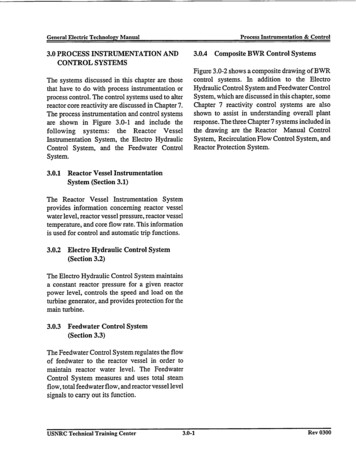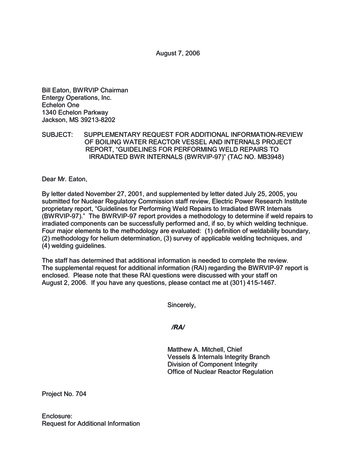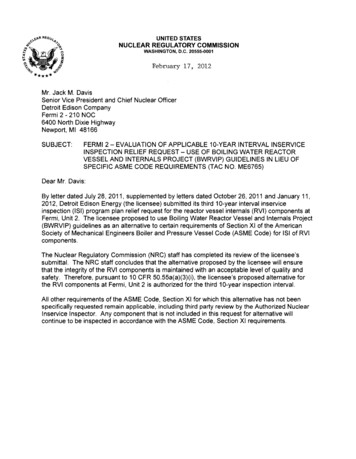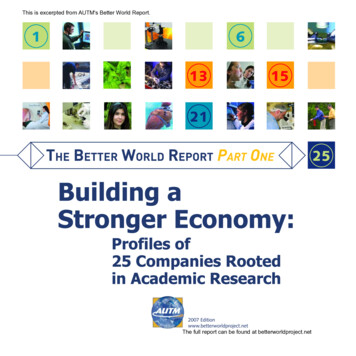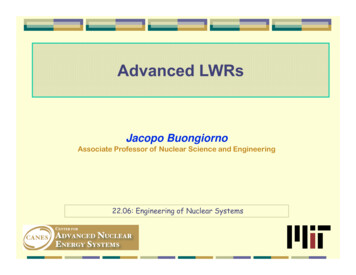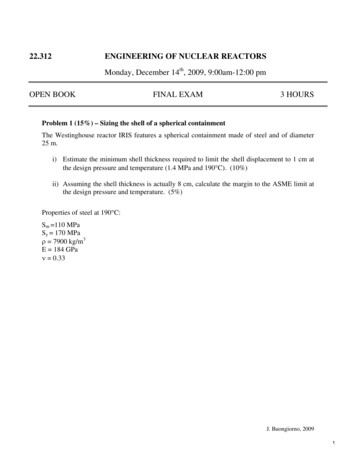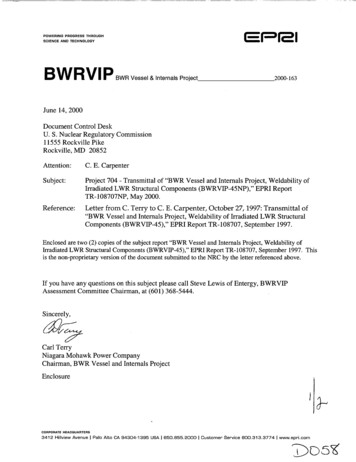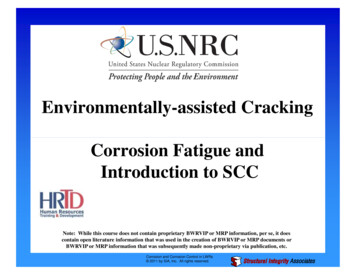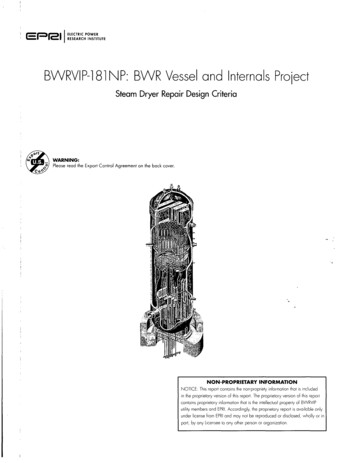
Transcription
IE F311ELECTRIC POWERRESEARCH INSTITUTEBWRVIP-1 81 NP: BWR Vessel and Internals ProjectSteam Dryer Repair Design CriteriaWARNING:Please read the Export Control Agreement on the back cover.NON-PROPRIETARY INFORMATIONNOTICE: This report contains the non-propriety information that is includedin the proprietary version of this report. The proprietary version of this reportcontains proprietary information that is the intellectual property of BWRVIPutility members and EPRI. Accordingly, the proprietary report is available onlyunder license from EPRI and may not be reproduced or disclosed, wholly or inpart, by any Licensee to any other person or organization.
BWRVIP-i 81 NP: BWR Vesseland Internals ProjectSteam Dryer Repair Design Criteria1013403NPFinal Report, November 2007EPRI Project ManagerR. CarterELECTRIC POWER RESEARCH INSTITUTE3420 Hillview Avenue, Palo Alto, California 94304-1338 PO Box 10412, Palo Alto, California 94303-0813 USA800.313.3774 650.855.2121 askepri@epri.com www.epri.com
DISCLAIMER OF WARRANTIES AND LIMITATION OF LIABILITIESTHIS DOCUMENT WAS PREPARED BY THE ORGANIZATION(S) NAMED BELOW AS ANACCOUNT OF WORK SPONSORED OR COSPONSORED BY THE BWR VESSEL AND INTERNALSPROJECT (BWRVIP) AND ELECTRIC POWER RESEARCH INSTITUTE, INC. (EPRI). NEITHERBWRVIP, EPRI, ANY MEMBER OF EPRI, ANY COSPONSOR, THE ORGANIZATION(S) BELOW,NOR ANY PERSON ACTING ON BEHALF OF ANY OF THEM:(A) MAKES ANY WARRANTY OR REPRESENTATION WHATSOEVER, EXPRESS OR IMPLIED, (I)WITH RESPECT TO THE USE OF ANY INFORMATION, APPARATUS, METHOD, PROCESS, ORSIMILAR ITEM DISCLOSED IN THIS DOCUMENT, INCLUDING MERCHANTABILITY AND FITNESSFOR A PARTICULAR PURPOSE, OR (11) THAT SUCH USE DOES NOT INFRINGE ON ORINTERFERE WITH PRIVATELY OWNED RIGHTS, INCLUDING ANY PARTY'S INTELLECTUALPROPERTY, OR (111)THAT THIS DOCUMENT IS SUITABLE TO ANY PARTICULAR USER'SCIRCUMSTANCE; OR(B) ASSUMES RESPONSIBILITY FOR ANY DAMAGES OR OTHER LIABILITY WHATSOEVER(INCLUDING ANY CONSEQUENTIAL DAMAGES, EVEN IF BWRVIP, EPRI OR ANY EPRIREPRESENTATIVE HAS BEEN ADVISED OF THE POSSIBILITY OF SUCH DAMAGES) RESULTINGFROM YOUR SELECTION OR USE OF THIS DOCUMENT OR ANY INFORMATION, APPARATUS,METHOD, PROCESS, OR SIMILAR ITEM DISCLOSED IN THIS DOCUMENT.ORGANIZATION(S) THAT PREPARED THIS DOCUMENTStructural Integrity AssociatesNON-PROPRIETARY INFORMATIONNOTICE:This report contains the non-propriety information that is included inthe proprietary version of this report. The proprietary version of thisreport contains proprietary information that is the intellectual propertyof BWRVIP utility members and EPRI. Accordingly, the proprietaryreport is available only under license from EPRI and may not bereproduced or disclosed, wholly or in part, by any Licensee to anyother person or organization.NOTEFor further information about EPRI, call the EPRI Customer Assistance Center at 800.313.3774 ore-mail askepri@epri.com.Electric Power Research Institute, EPRI, and TOGETHER. SHAPING THE FUTURE OF ELECTRICITYare registered service marks of the Electric Power Research Institute, Inc.Copyright 2007 Electric Power Research Institute, Inc. All rights reserved.
CITATIONSThis report was prepared byStructural Integrity Associates3315 Almaden Expressway, Suite 24San Jose, CA 95135Principal InvestigatorsM. HerreraT. GiannuzziThis report describes research sponsored by the Electric Power Research Institute (EPRI) and itsBWRVIP participating members.The report is a corporate document that should be cited in the literature in the following manner:BWRVIP-181NP: BWR Vessel and InternalsProject, Steam Dryer Repair Design Criteria.EPRI,Palo Alto, CA: 2007. 1013403NP.iii
REPORT SUMMARYThe Boiling Water Reactor Vessel and Internals Project (BWRVIP), formed in June 1994, is anassociation of utilities focused exclusively on BWR vessel and internals issues. This BWRVIPreport provides design guidance for the repair or replacement of steam dryers.BackgroundRecent experience at several BWRs, particularly those operating at extended power uprate (EPU)conditions with high steam flow velocities, have shown significant degradation in the steamdryer caused by acoustic loads. In response to this issue, General Electric and the BWRVIPdeveloped BWRVIP-139, Steam Dryer Inspection and Flaw Evaluation Guidelines (EPRI report1011463). In addition to this inspection guidance, generic criteria are needed for the design ofrepairs to address observed or anticipated steam dryer degradation.ObjectiveTo provide general design guidance and acceptance criteria for permanent and temporary repairor replacement of steam dryers and/or steam dryer components.ApproachThe project team assembled the key attributes that need to be considered in designingmodifications to or total replacement of a steam dryer. Items discussed include: designobjectives; structural evaluation; system evaluation; materials, fabrication, and installationconsiderations; and, required inspection and testing.ResultsThe document provides general design acceptance criteria for the repair and replacement ofsteam dryers. Repairs or replacements designed to meet these criteria will maintain the structuralintegrity of the component under normal operation as well as under postulated transient anddesign basis accident conditions.EPRI PerspectiveThe criteria listed in the report define a standard set of considerations that are important inplanning steam dryer repair or replacement. They will assist BWR owners in designing repairs orreplacements that maintain the structural integrity and system functionality of the steam dryer.Regulatory acceptance of these generic criteria will significantly reduce the utility effort requiredto obtain approval for plant-specific repairs or total steam dryer replacement.v
KeywordsBoiling Water ReactorSteam DryerFlow-Induced VibrationFatigueStress Corrosion CrackingBWR Vessel and Internalsvi
EXECUTIVE SUMMARYThe Boiling Water Reactor Vessel and Internals Project (BWRVIP) was formed in June 1994as a utility-directed initiative to address BWR vessel and internals issues. This criteria documentwas developed under the guidance of the Repair Focus Group of the BWRVIP.This document provides the general design acceptance criteria for permanent or temporary repairor replacement of steam dryers. It is provided to assist BWR owners in designing repairs orreplacements which maintain the structural integrity and system functionality of the steam dryerduring normal operation and under postulated transient and design basis accident conditions forthe remaining plant life or other service life as specified by the plant owner.Issuance of this document is not intended to imply that repair of a steam dryer is the only viablemethod for resolving cracking. Due to variations in the material, fabrication, environment and asfound condition of individual components, and depending upon which component is degraded,repair is only one of several options that are available. Replacement of the steam dryer is anotheroption, and is discussed in detail in this document. The action to be taken for individual plantswill be determined by the plant licensee.vii
CONTENTS1 INTRO DUCTIO N .1-11.1 Background .1-11 .2 P u rp o s e .1-11 .3 S c o pe .1-21.4 Im plementation Guidelines .1-22 DEFINITIONS .2-12.1 Replacem ent .2-12 .2 R e pa ir.2 -12.3 Steam Dryer Assembly .2-12.4 Safety Analysis Report .2-13 STEAM DRYER ASSEMBLY CONFIGURATION AND SAFETY FUNCTION . 3-13.1 Generic Physical Description .3-13.1.1 Materials and Construction .3-193.1.2 Environm ent .3-203.2 Safety Design Bases .3-203.3 Event Analyses .3-213.3.1 Norm al O peration .3-213.3.2 Anticipated Operational Occurrence (Upset Conditions) .3-223.3.3 Design Basis Accidents (Em ergency/Faulted Conditions) .3-223.3.4 Loading Com binations .3-224 SCO PE O F REPAIRS .4-14.1 Scope of Repairs .4-15 DESIG N O BJECTIVES .5-15.1 Design Life .5-15.2 Safety Design Bases .5-1ix
5.3 Safety Analysis Events .5-15.4 Structural Integrity .5-15.5 Retained Flaws .5-25.6 Loose Parts Considerations .5-25.7 Physical Interfaces W ith Other Reactor Internals .5-35 .8 In sta llatio n .5 -35.9 Steam Dryer Performance and Leakage .5-35.10 Design Verification .5-45.11 Multiple Repairs .5-46 GENERAL DESIGN CRITERIA .6-17 STRUCTURAL AND DESIGN EVALUATION .7-17.1 Load Definitions-Applied Loads .7.1.1 Applicability of Hydrodynamic Loads .7-17.1.2 Deadweight (DW ) .7-27.1.3 Hydraulic Loads (F) .7-27.1.4 Differential Pressure (DP) .7-27.1.5 Seismic Inertia .7-27.1.6 Seismic Anchor Displacements .7-37.1.7 Safety Relief Valve Opening (SRV) .7-37.1.8 Flow Induced Vibration (FIV) .7-47.1.9 Thermal and Pressure Anchor Displacem ent (D) .7-47.1.10 Turbine Stop Valve (TSV).7-57.1.11 Main Steam Line Break (MSLB) .7-57.2 Service Level Conditions .7-57.2.1 Service Level A (Normal Operating Conditions) .7-57.2.2 Service Level B (Upset Conditions) .7-67.2.3 Service Level C (Emergency Conditions) .7-67.2.4 Service Level D (Faulted Conditions) .7-67.3 Load Combinations .7-67.3.1 Mark I Plants .7-77.3.2 Mark II and III Plants .7-87.4 Analysis Methodology .7-97.5 Allowable Stresses .x7-17-10
7.6 Flow Induced Vibration .7-107.7 Impact on Existing Internal Components .7-117.8 Radiation Effects on Repair Design .7-117.9 Analysis Codes .7-117.10 Thermal Codes .7-117.11 Corrosion Allowance .7-1 18 SYSTEM EVALUATION .8-18 .1 Le a ka g e .8 -18.2 Internal Steam Dryer Pressure Drop .8-18.3 Impact to Flow Distribution .8-18.4 Emergency Operating Procedure (EOP) Calculations .8-18.5 Power Uprate .8-29 MATERIALS, FABRICATION AND INSTALLATION .9-19.1 Materials, Fabrication and W elding .9-19.2 Materials, Fabrication and Installation Requirements .9-19 .2.1 C rev ic e s .9 -19.2.2 Pre-Installation As Built Inspection .9-19.2.3 Post-Installation As-Built Inspection .9-29.2.4 Installation Cleanliness .9-29.2.5 ALARA .9-29.2.6 Qualification of Critical Design Parameters and Process .9-39.2.7 Peak Stresses and Strains .9-39.2.8 Surface Roughness .9-39.2.9 W elding .9-49.2.10 Repairs to Material .9-49.2.11 Cold W ork .9-59.2.12 Forming and Bending .9-59.2.13 Augmented NDE Requirements .9-59.3 Steam Dryer Vanes .9-510 INSPECTION AND TESTING .10-110.1 Inspection Access .10-110.2 Pre and Post Installation Inspection .10-1Xi
10.3 Testing .10-211 Q UALITY ASSURANCE PRO G RAM .11-112 DESIG N BASIS DO CUM ENTATIO N .12-113 CO NCEPTUA L DESIG NS .13-113.1 Exam ple Conceptual Designs/O ptions .13-113.1.1 Stop Drilling .13-113.1.2 W eld Reinforcem ent/Enhancem ent .13-513.1.3 Added Structural Reinforcem ent .13-513.1.4 Rem oval of Cracked Com ponents .13-513.1.5 Leave As-Is .13-513.1.6 G rinding and Rewelding .13-613.1.7 Replacem ent .13-613.2 Acoustic Load M itigation .13-613.3 BW R Steam Dryer Cracking and Repair Experience .13-713.4 Exam ple Repair Configurations .13-714 REFERENCES .xii14-1
LIST OF FIGURESFigure 3-1 Typical BWR Steam Dryer Flow Path and Terminology [1] . 3-1Figure 3-2 Horizontal Section (Section A-A of Figure 2-1) Through Typical BWR SteamDryer Vane Modules (Dryer Units) (Note: Tie Rod Nuts Differ Between BWR 4/5and BWR 6 as Shown) [1]. Lower Figure Shows Example of One Cam Nut Design . 3-2Figure 3-3 Typical BWR 4/5/6 Steam Dryer Vane Module (Dryer Unit) Requirements [1] . 3-3Figure 3-4 Evolution of Steam Dryers and Dryer Hood Designs Types (Some LaterBW R-4s A lso had C urved Hoods) [1] .3-4Figure 3-5 213-BWR/2 Dryer Cross-Section [1] .3-5Figure 3-6 251-BW R/3 D ryer Isom etric [1] .3-6Figure 3-7 251-BW R/3 Bank Details [1] .3-7Figure 3-8 158-BWR/4 Steam Dryer With RPV (Dimensions in MM) [1] . 3-8Figure 3-9 205-BWR/3/4 Steam Dryer Assembly [1] .3-9Figure 3-10 188-BW R/3 D ryer in RPV [1] .3-10Figure 3-11 224-BWR/3 Dryer Cross-Section [1] .3-11Figure 3-12 BWR/4 Slanted Hood Steam Dryer [1] .3-12Figure 3-13 218-BWR/4 Dryer Installed in RPV [1] .3-13Figure 3-14 183-BWR/4 Dryer Installed In RPV [1] .3-14Figure 3-15 251 -BWR/4 Dryer Installed In RPV [1] .3-15Figure 3-16 BWR/4/5/6 Curved Hood Steam Dryer [1] .3-16Figure 3-17 251 BWR/4/5 Dryer Installed in RPV [1] .3-17Figure 3-18 218 BWR/4 Dryer Installed in RPV [1] .3-18Figure 3-19 218-BWR/6 Dryer Installed In RPV [1] .3-19Figure 13-1 251 -BWR/3 Outer Bank Modifications .13-8Figure 13-2 Brunswick 1 Outer Bank Hood Gusset .13-9Figure 13-3 BWR/4/5 Outer Hood Modification .13-10Figure 13-4 Reinforcement Strip of the Middle Bank .13-11Figure 13-5 251 BWR/4/5 Steam Dryer Modification [1] .13-12xliii
LIST OF TABLESTableTableTableTableTableTable1-1 Plant Configurations Evaluated .6-1 Summary of ASME Code Design Guidance* .7-1 Load Combinations for Mark I Plants .7-2 Load Combinations for Mark II & III Plants .7-3 Load Term Definitions for Tables 7-1 and 7-2 .13-1 BWR Steam Dryer Information .1-26-37-77-87-913-2xv
1INTRODUCTION1.1 BackgroundThe Boiling Water Reactor and Internals Project (BWRVIP) has developed a series of RepairDesign Criteria that provide guidance for repair of certain reactor internals components. Thisreport documents criteria for the repair or replacement of steam dryers. Recent experience withthe steam dryers at operating BWRs, particularly those operating at Extended Power Uprate(EPU) conditions with high steam line flow velocities, have shown significant degradation inthe dryer caused by acoustic resonance induced loads. In response to this issue, GE and theBWRVIP developed an inspection and flaw evaluation guideline for the steam dryer, BWRVIP139 [1]. As a result of the inspections performed, repairs and modifications have been requiredat some plants. In some cases, the observed damage has been sufficiently extensive thatreplacement dryers have been installed.In conjunction with the inspection and flaw evaluation guidelines, a repair design criteria isoutlined here for cases in which repair or replacement of the steam dryer or steam dryercomponents is warranted. Note that this repair design criteria supersedes any repair guidanceprovided in BWRVIP- 139. However, BWRVIP- 139 is still valid for routine inspection criteria.1.2 PurposeThe purpose of this document is to provide general design guidance and acceptance criteria forpermanent and temporary repair of existing steam dryers or steam dryer components and for thedesign of replacement steam dryers. The guidance is applicable to the repair of existing damageas well as to performing preemptive modifications to steam dryers in preparation for operation athigher power levels, e.g., EPU. It is expected that individual licensees and vendors will adhere tothese criteria in the application of plant specific repair and replacement activities.The issuance of this document is not intended to imply that repair or replacement of steam dryersor steam dryer components is the only viable approach to resolution of the cracking/degradationissue.1-1
Introduction1.3 ScopeThis document is applicable to General Electric BWR/2-6 plants. Table 1-1 shows the plantconfigurations that were specifically evaluated in preparing this Guideline. Configuration andmaterial information included in the guideline is based on the best information available. Plantsare advised to confirm the accuracy of this information when designing repairs or replacements.Table 1-1Plant Configurations EvaluatedPlant TypePlant NameBWR/2Oyster Creek, Nine Mile Point 1BWR/3Millstone, Pilgrim, Monticello, Quad Cities 1, 2, Dresden 2, 3, SantaMaria de Garofia, KKM, 1 Fukushima 1BWR/4Vermont Yankee, Fermi 2, Hope Creek 1, Limerick 1, 2, Susquehanna 1,2, Browns Ferry 1, 2, 3, Peach Bottom 2, 3, Brunswick 1, 2, Hatch 1,2,Cooper, 1 Fukushima 2, Fitzpatrick, Duane Arnold, Chinshan 1, 2BWR/5LaSalle 1,2, Laguna Verde 1,2, Nine Mile Point 2, ColumbiaBWR/6Perry 1, Grand Gulf 1, River Bend, Clinton 1, Cofrentes, Kuo Sheng 1 &2, KKL1.4 Implementation GuidelinesIn accordance with the implementation requirements of Nuclear Energy Institute (NEI) 03-08,Guideline for the Management of Materials Issues, this report is considered to be "needed."1-2
2DEFINITIONS2.1 ReplacementReplacement as used in the context of this document constitutes removal of a steam dryerassembly and installation of a completely new steam dryer assembly.2.2 RepairRepair as used in the context of this document is a broad term that applies to actions taken todesign, analyze, fabricate and install hardware that restores or addresses the structural andfunctional integrity of the steam dryer assembly. In performing repairs, flaws are sometimes leftin place. Weld buildup/repair, without removal of the defect, as well as removal of flaws by aqualified machining process, including hole drilling of crack tips, are also considered repairs inthe context of this document. Repairs may also include removal of flaws by underwater grinding.The repairs can be temporary, i.e. designed for a specified amount of time, e.g. months ofoperation, or permanent, i.e., designed for the remaining plant operating term.Repairs also include preemptive modifications in preparation for operation at higher powerlevels, e.g., EPU.2.3 Steam Dryer AssemblySteam Dryer Assembly is used in the context of this document to mean the entire steam dryerincluding the vane modules, attached support structure, and all internal components. The steamdryer support attachments which are welded to the RPV are covered under a separate repairdesign criteria.2.4 Safety Analysis ReportSafety Analysis Report (SAR) is used throughout this design criteria to refer to the currentlicensing document for the plant (e.g., FSAR, UFSAR, etc.).2-1
3STEAM DRYER ASSEMBLY CONFIGURATION ANDSAFETY FUNCTION3.1 Generic Physical DescriptionA typical GE BWR steam dryer, with its flow paths, is shown in Figure 3-1. Wet steam flowsupward from the steam separators into an inlet header, horizontally through the perforated plates(if applicable) and dryer vanes, vertically in an outlet header and into the RPV dome. Steamthen exits the reactor pressure vessel (RPV) through steam outlet nozzles. Moisture (liquid) isseparated from the steam by the vane surface and the hooks attached to the vanes (see Figure 3-2and Figure 3-3). The captured moisture flows downward under the force of gravity to acollection trough that carries the liquid flow to drain pipes and vertical drain channels. The liquidflows by gravity through the vertical drain channels to the lower end of the skirt where the flowexits below normal water level.Content Deleted EPRI Proprietary InformationFigure 3-1Typical BWR Steam Dryer Flow Path and Terminology [1]3-1
Steam Dryer Assembly Configuration and Safety FunctionContent Deleted EPRI Proprietary InformationFigure 3-2Horizontal Section (Section A-A of Figure 2-1)
REPORT SUMMARY The Boiling Water Reactor Vessel and Internals Project (BWRVIP), formed in June 1994, is an association of utilities focused exclusively on BWR vessel and internals issues.
